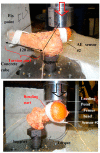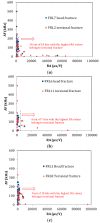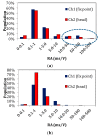Fracture of human femur tissue monitored by acoustic emission sensors
- PMID: 25763648
- PMCID: PMC4435197
- DOI: 10.3390/s150305803
Fracture of human femur tissue monitored by acoustic emission sensors
Abstract
The study describes the acoustic emission (AE) activity during human femur tissue fracture. The specimens were fractured in a bending-torsion loading pattern with concurrent monitoring by two AE sensors. The number of recorded signals correlates well with the applied load providing the onset of micro-fracture at approximately one sixth of the maximum load. Furthermore, waveform frequency content and rise time are related to the different modes of fracture (bending of femur neck or torsion of diaphysis). The importance of the study lies mainly in two disciplines. One is that, although femurs are typically subjects of surgical repair in humans, detailed monitoring of the fracture with AE will enrich the understanding of the process in ways that cannot be achieved using only the mechanical data. Additionally, from the point of view of monitoring techniques, applying sensors used for engineering materials and interpreting the obtained data pose additional difficulties due to the uniqueness of the bone structure.
Figures











References
-
- Grosse C.U., Ohtsu M. Acoustic Emission Testing. Springer; Heidelberg, Germany: 2008.
-
- Han Z., Luo H., Cao J., Wang H. Acoustic emission during fatigue crack propagation in a micro-alloyed steel and welds. Mater. Sci. Eng. A. 2011;528:7751–7756. doi: 10.1016/j.msea.2011.06.065. - DOI
-
- Carpinteri A., Corrado M., Lacidogna G. Heterogeneous materials in compression: Correlations between absorbed, released and acoustic emission energies. Eng. Fail. Anal. 2013;33:236–250. doi: 10.1016/j.engfailanal.2013.05.016. - DOI
-
- Maillet E., Godin N., R’Mili M., Reynaud P., Fantozzi G., Lamon J. Damage monitoring and identification in SiC/SiC minicomposites using combined acousto-ultrasonics and acoustic emission. Composites. 2014;57:8–15. doi: 10.1016/j.compositesa.2013.10.010. - DOI
-
- Philippidis T.P., Assimakopoulou T.T. Strength degradation due to fatigue-induced matrix cracking in FRP composites: An acoustic emission predictive model. Compos. Sci. Technol. 2008;68:3272–3277. doi: 10.1016/j.compscitech.2008.08.020. - DOI
MeSH terms
LinkOut - more resources
Full Text Sources
Other Literature Sources
Medical

